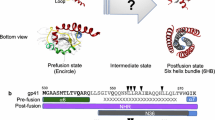Abstract
The membrane proximal external region (MPER) of gp41 is extremely conserved among diverse HIV-1 variants, implying its important role in viral infection. Interestingly, two of the most broadly neutralizing antibodies, 2F5 and 4E10, specifically recognize this region. Our previous study demonstrated that the antigenicity and immunogenicity of 4E10 epitope are affected by remodeling gp41 fusion core, suggesting that the MPER may be associated with gp41 core and involved in gp41-mediated membrane fusion. Here we measured the binding activity of 4E10 epitope peptide (D4E10P) with various gp41 core-derived peptides and found that the N-trimer region in a construct designated N-trimer-6HB interacted significantly with D4E10P. Using N-trimer-6HB to screen a phage library, we identified a motif (WF) located in 4E10 epitope that may play a certain role in the interaction of gp41 MPER with the N-trimer in gp41 fusion core and, we thus speculated upon the potential involvement of MPER in the fusion process between viral envelope and target cell membrane.
Similar content being viewed by others
References
Binley J M, Wrin T, Korber B, et al. Comprehensive cross-clade neutralization analysis of a panel of anti-human immunodeficiency virus type 1 monoclonal antibodies. J Virol, 2004, 78(23): 13232–13252
Cardoso R M, Zwick M B, Stanfield R L, et al. Broadly neutralizing anti-HIV antibody 4E10 recognizes a helical conformation of a highly conserved fusion-associated motif in gp41. Immunity, 2005, 22(2): 163–173
Zwick M B, Labrijn A F, Wang M, et al. Broadly neutralizing antibodies targeted to the membrane-proximal external region of human immunodeficiency virus type 1 glycoprotein gp41. J Virol, 2001, 75(22): 10892–10905
Salzwedel K, West J T, Hunter E. A conserved tryptophan-rich motif in the membrane-proximal region of the human immunodeficiency virus type 1 gp41 ectodomain is important for Env-mediated fusion and virus infectivity. J Virol, 1999, 291(73): 2469–2480
Munoz-Barroso I, Salzwedel K, Hunter E, et al. Role of the membrane-proximal domain in the initial stages of human immunodeficiency virus type 1 envelope glycoprotein-mediated membrane fusion. J Virol, 1999, 73(7): 6089–6092
Day J R, Munk C, Guatelli J C. The membrane-proximal tyrosinebased sorting signal of human immunodeficiency virus type 1 gp41 is required for optimal viral infectivity. J Virol, 2004, 78(3): 1069–1079
Suarez T, Gallaher W R, Agirre A, et al. Membrane interface-interacting sequences within the ectodomain of the human immunodeficiency virus type 1 envelope glycoprotein: putative role during viral fusion. J Virol, 2000, 74(17): 8038–8047
Vishwanathan S A, Hunter E. Importance of the membrane-perturbing properties of the membrane-proximal external region of human immunodeficiency virus type 1 gp41 to viral fusion. J Virol, 2008, 82(11): 5118–5126
Yu H, Tudor D, Alfsen A, et al. Peptide P5 (residues 628–683), comprising the entire membrane proximal region of HIV-1 gp41 and its calcium-binding site, is a potent inhibitor of HIV-1 infection. Retrovirology, 2008, 5(1): 93
Dimitrov A S, Rawat S S, Jiang S, et al. Role of the fusion peptide and membrane-proximal domain in HIV-1 envelope glycoprotein-mediated membrane fusion. Biochemistry, 2003, 42(48): 14150–14158
Li J, Chen X, Jiang S, et al. Deletion of fusion peptide or destabilization of fusion core of HIV gp41 enhances antigenicity and immunogenicity of 4E10 epitope. Biochem Biophys Res Commun, 2008, 376(1): 60–64
Louis J M, Bewley C A, Clore G M. Design and properties of N(CCG)-gp41, a chimeric gp41 molecule with nanomolar HIV fusion inhibitory activity. J Biol Chem, 2001, 276(31): 29485–29489
Li J, Chen X, Huang J H, et al. Identification of critical antibody-binding sites in the HIV-1 gp41 six-helix bundle core as potential targets for HIV-1 fusion inhibitors. Immunobiology, 2008, doi: 10.1016/j.imbio.2008.04.005
Huang J H, Liu Z Q, Liu S, et al. Identification of the HIV-1 gp41 core-binding motif—HXXNPF. FEBS Lett, 2006, 580(20): 4807–4814
Louis J M, Bewley C A, Gustchina E, et al. Characterization and HIV-1 fusion inhibitory properties of monoclonal Fabs obtained from a human non-immune phage library selected against diverse epitopes of the ectodomain of HIV-1 gp41. J Mol Biol, 2005, 353(5): 945–951
Zwick M B, Jensen R, Church S, et al. Anti-human immunodeficiency virus type 1 (HIV-1) antibodies 2F5 and 4E10 require surprisingly few crucial residues in the membrane-proximal external region of glycoprotein gp41 to neutralize HIV-1. J Virol, 2005, 79(2): 1252–1261
Cardoso R M, Brunel F M, Ferguson S, et al. A Structural basis of enhanced binding of extended and helically constrained peptide epitopes of the broadly neutralizing HIV-1 antibody 4E10. J Mol Biol, 2007, 365: 1533–1544
Brunel F M, Zwick M B, Cardoso R M, et al. Structure-function analysis of the epitope for 4E10, a broadly neutralizing human immunodeficiency virus type 1 antibody. J Virol, 2006, 80(4): 1680–1687
Nakowitsch S, Quendler H, Fekete H, et al. HIV-1 mutants escaping neutralization by the human antibodies 2F5, 2G12, and 4E10: in vitro experiments versus clinical studies. AIDS, 2005, 19(17): 1957–1966
Chan D C, Kim P S. HIV entry and its inhibition. Cell, 1998, 93(5): 681–684
Weissenhorn W, Dessen A, Harrison S C, et al. Atomic structure of the ectodomain from HIV-1 gp41. Nature, 1997, 387(6631): 426–430
Author information
Authors and Affiliations
Corresponding authors
Additional information
Supported by National Key Basic Research and Development Program of China (Grant No. 2007CB914402)
About this article
Cite this article
Li, J., Lu, L., Wu, F. et al. The interaction between the membrane-proximal external region and the N-trimer region of HIV-1 gp41: Involvement in viral fusion. Chin. Sci. Bull. 54, 1707–1712 (2009). https://doi.org/10.1007/s11434-009-0280-6
Received:
Accepted:
Published:
Issue Date:
DOI: https://doi.org/10.1007/s11434-009-0280-6




